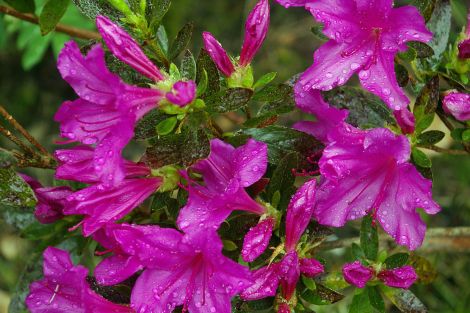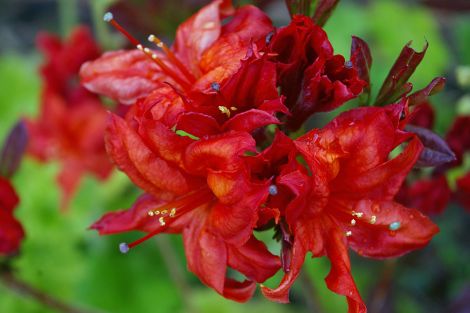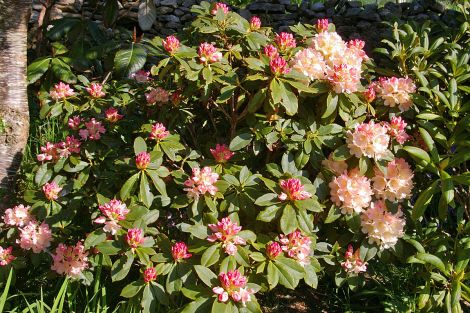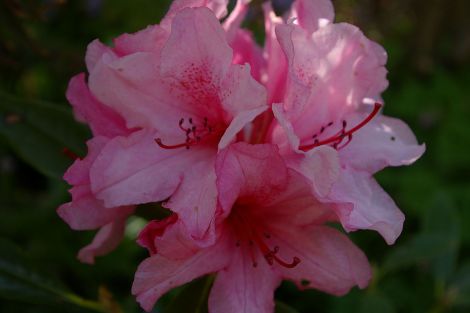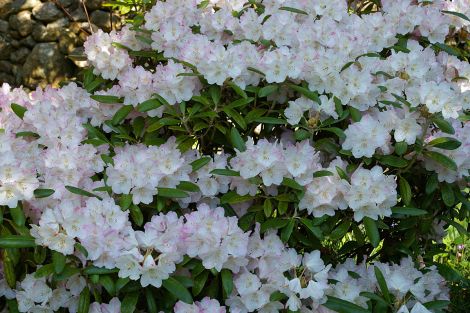Four Seasons / Four Seasons – Late Spring 2013
It’s been a very compacted season – some daffodils still in flower, while the May rhododendrons are out – definitely a Shetland first, but highly enjoyable.
Myths and legends surround rhododendron growing in Shetland, and two questions pop up frequently at Lea Gardens nursery: “Can they actually grow up here?” and “won’t they take over the island?”
The answer to the second question is straightforward. The only rhododendron capable of taking over’ is Rhododendron ponticum, which has swallowed up acres of land since its British introduction in the 18th century.
In Shetland it finds itself at the very margin of its natural habitat, ie. a highly continental climate with warm summers and cold winters.
Seedlings I collected at high altitudes and at exposed sea level sites in Argyll over a decade ago have still to produce a single seedling. This leads me to conclude that Shetland won’t be swallowed up by rhododendrons.
The answer to the second question is a little more complicated. Some rhodos don’t have much of a chance in our windy and salt-laden climate, while others not only survive, but actually thrive in it.
The so-called hardy hybrids were recommended when I started my rhodo collection, but ‘Mrs. Leask’, ‘Gomer Waterer’ and others whose names I’ve mercifully forgotten, don’t cut the mustard.
Top of the list for 60º North comes Rhododendron yakushimanum and its hybrids. The species hails from a wind-swept, salt-drenched Japanese island and has leathery leaves covered in a thick indumentum on their reverses, rendering it all but immune to the Shetland climate. It makes a dense, rounded bush, smothered in blush-white flowers, which open from cherry-pink buds – a perfect treasure.
The species has given rise to countless hybrids, and all we have tried at Lea Gardens are thriving – with one exception: ‘Titian Beauty’, a reddish cultivar, has sparse growth and is prone to ugly leaf spots. When choosing a “yak” for your garden, this is the only name you have to remember. Regardless of how lush and floriferous it looks in a garden centre – give it a wide berth.
Become a member of Shetland News
Yak cultivars that thrive and flower freely in Shetland are too numerous to mention, but most have one thing in common: They change colour – a characteristic inherited from their wild parent – and are a great spectacle to observe during May and early June, as red and dark pink buds open and chance to cerise, sugar pink and palest blossom pink as the season progresses.
‘Mistmaiden’ is one of my favourites and a welcome change from the pink theme. It has all the characteristics of the yak parent and its pink buds open to pure white flowers.
Yak hybrids are compact plants, reaching a height of about three feet and are as wide. They like an acid soil, but can be grown in Shetland’s limestone regions, provided some peat is dug into the ground at planting time, and/or the shrubs are mulched with granite chips, which are available from the Scord quarry.
Their glory doesn’t end with the fading of their blossom, for as soon as the last flower has dropped, the new foliage makes progress in grey, cream, fawn, or silver.
Alpine rhododendrons also do well in Shetland, provided they can be given a modicum of shelter and a sunny aspect.
Amongst the very best is the Glendoick bird series. Near prostrate ‘Razorbill’ has tubular pink bells. ’Merganser’ is a low-growing shrublet with large pale yellow flowers, while ‘Arctic Tern’ is smothered in little white thimbles. ‘Quail’ is a reddish pink and ‘Brambling’, one of my favourites, has an upright habit and flowers of a clear, vivid pink.
Once upon a time there was a division between rhododendrons and azaleas, but both have since been deemed to belong to the same genus. For the sake of clarity, I shall stick with the old name and move on to “azaleas”.
My acquaintance with evergreen azaleas has been highly enjoyable, largely thanks to more Glendoick breeding. Their small mammal series has given rise to a race of highly floriferous, compact shrubs. ‘Wombat’, ‘Squirrel’, ‘Marmot’ and ‘Beaver’ all thrive here. They come into flower as most of the “rhododendrons” go over. Pinks and reds predominate on tough, compact shrubs, which tend to be wider than high and completely smothered in large blossom. Unlike many rhododendrons, they can be pruned hard after flowering to keep them in shape. ‘Blue Danube’ is worth a try, not blue, but a rich purple on a low, wide bush.
For sheer June flamboyance deciduous azaleas are hard to beat. So far, I only have three in my garden, but intend to add more. Rhododendron luteum alias Azalea pontica has maize-yellow flowers and a scent to die for. ‘Persil’ is white with a prominent yellow flare, and ‘Fireball’ is a smouldering orange-red with dark foliage to match.
They are vigorous shrubs, capable of rejuvenation by producing vigorous new growth from the base – definite survivors.
All rhododendrons (incl. azaleas) in my garden flower with extreme freedom, and one of the great pleasures in life is cutting blossom for the house.
I shall end with a gripe – a severe one. Browsing the shrub section in a garden centre I came across a patented cultivar of Weigela middendorffiana. Nature should be freely available to everybody. Nobody should be allowed to own nature!
W. middendorffiana has sizeable foxglove-like primrose yellow flowers with prominent rusty-red throat marking.
The one I’ve had in my garden for near on 20 years is as good, if not superior, to the patented plant. Alas, this patent prevents me from legally propagating my weigela for sale.
I have some beautiful young specimens in the nursery, raised from cuttings struck last year. If you don’t hear from me in the near future, I’ll probably be in jail…..
Rosa Steppanova (www.leagardens.co.uk)
Become a member of Shetland News
Shetland News is asking its many readers to consider paying for membership to get additional features and services: -
- Remove non-local ads;
- Bookmark posts to read later;
- Exclusive curated weekly newsletter;
- Hide membership messages;
- Comments open for discussion.
If you appreciate what we do and feel strongly about impartial local journalism, then please become a member of Shetland News by either making a single payment, or setting up a monthly, quarterly or yearly subscription.






